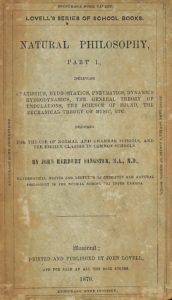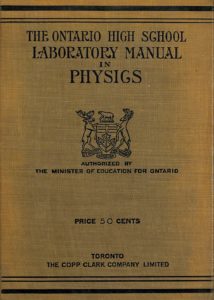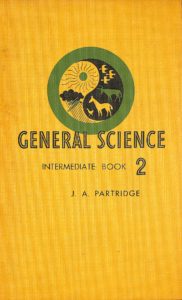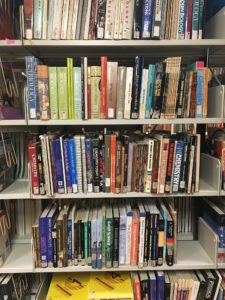Science Literacy Week is September 18-24, 2017! This month’s historical display takes a look at how science literacy and science education has evolved in Ontario schools through the year 2000.
 The earliest science textbooks in the Ontario Historical Education Collection were published in the mid-1800s. Books from this period include Comstock’s A System of Natural Philosophy (1838) and Sangster’s Natural Philosophy (1861; 1870 printing on display). While they pre-date the official lists of textbooks approved for use in Ontario schools, as these came into existence in 1887, these books include a statement on the title page that they were designed for use in schools.
The earliest science textbooks in the Ontario Historical Education Collection were published in the mid-1800s. Books from this period include Comstock’s A System of Natural Philosophy (1838) and Sangster’s Natural Philosophy (1861; 1870 printing on display). While they pre-date the official lists of textbooks approved for use in Ontario schools, as these came into existence in 1887, these books include a statement on the title page that they were designed for use in schools.
By the late 1800s and early 1900s, the province was publishing curricula for use in Ontario schools. Public school students’ first experience with science was through a class called “Nature Study,” which was an obligatory course of study in Forms I-IV (today’s grades 1-8). Children in nature study classes were expected to interact directly with nature – as a result, the only textbooks produced about nature study were teacher’s guides, such as the Ontario Teachers’ Manuals: Nature Study (1926).
 In high school, students studied Elementary Science in the Lower School (grades 9-10), which covered botany, zoology, physics, and chemistry. Students in the Middle School (grades 11 and 12) studied Physics and Chemistry, with Biology re-introduced in the Upper School (grade 13). Textbooks in physics and chemistry, such as Ontario High School Physics (1911) and Ontario High School Chemistry (1917), and their accompanying laboratory manuals were published for use in Ontario schools.
In high school, students studied Elementary Science in the Lower School (grades 9-10), which covered botany, zoology, physics, and chemistry. Students in the Middle School (grades 11 and 12) studied Physics and Chemistry, with Biology re-introduced in the Upper School (grade 13). Textbooks in physics and chemistry, such as Ontario High School Physics (1911) and Ontario High School Chemistry (1917), and their accompanying laboratory manuals were published for use in Ontario schools.
In 1937, the Ontario school curriculum introduced an intermediate level of schooling which separated grades 7 and 8 from grades 1-6. The “Natural Science” course for grades 1-6 was predominantly observation-based and continued to emphasize plants and animals in their natural setting. The Science course for students in grades 7 and 8, meanwhile, was designed “to employ the adolescent child’s curiosity as to why things happen as they do” (Ontario Programme of Studies for Grades VII and VIII of the Public and Separate Schools, 1938). However, teachers were advised to take care not to confuse students with content that was more appropriate for high school. With the move away from Nature Study, the province began issuing textbooks for grades 7 and 8, such as the General Science for Intermediate Grades series published in the 1950s.
 High school science during this period was divided into two streams: General Science and Agricultural Science. The underlying principles and objectives of these two streams were similar, although their content differed in focus. Similar to earlier years, the General Science stream emphasized the study of Physics and Chemistry. By contrast, the Agricultural Science course was an applied course of study intended to integrate schoolwork with the activities of the farm and community; the focus was on topics such as raising livestock and crops.
High school science during this period was divided into two streams: General Science and Agricultural Science. The underlying principles and objectives of these two streams were similar, although their content differed in focus. Similar to earlier years, the General Science stream emphasized the study of Physics and Chemistry. By contrast, the Agricultural Science course was an applied course of study intended to integrate schoolwork with the activities of the farm and community; the focus was on topics such as raising livestock and crops.
The next substantial change in the curriculum came about in 1961. The Intermediate Division was expanded to include grades 7-10, with grades 11-13 comprising the Senior Division. Furthermore, separate curricula for each subject of study were also being published instead of a single curriculum document that covered all subjects of study. By 1961, science education had become a greater priority for schools and scientific concepts were being introduced at increasingly early ages.
 The importance of science education and science literacy continued to increase through the 1970s. Curriculum documents began to grow in size – the 1987 science curriculum for the intermediate and senior divisions was published in 15 parts, each its own 50-page booklet! Accordingly, the science curriculum from 1987 asserts that “the characteristics of science and the needs of society indicate that science education should be given high priority in the schooling of all young people.” It is not surprising that the selection of textbooks in all areas of science also grew exponentially in the late 20th century.
The importance of science education and science literacy continued to increase through the 1970s. Curriculum documents began to grow in size – the 1987 science curriculum for the intermediate and senior divisions was published in 15 parts, each its own 50-page booklet! Accordingly, the science curriculum from 1987 asserts that “the characteristics of science and the needs of society indicate that science education should be given high priority in the schooling of all young people.” It is not surprising that the selection of textbooks in all areas of science also grew exponentially in the late 20th century.
At the turn of the century, science literacy remained a key aspect of education in Ontario:
During the twentieth century, science has come to play an increasingly important role in the lives of all Canadians […] There is every reason to expect that science and its impact on our lives will continue to grow as we enter the twenty-first century. Consequently, scientific literacy for all has become the goal of science education throughout the world. (The Ontario Curriculum Grades 9 and 10, Science, 1999)
With Science Literacy Week now upon us, a selection of historical science curricula and textbooks are available to view in the glass display table on the ground floor of the OISE Library.
